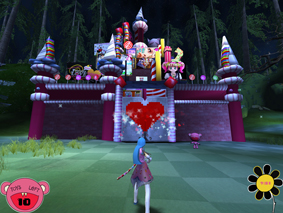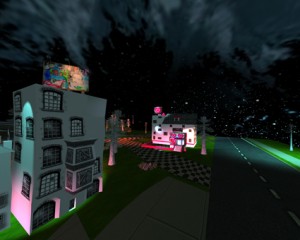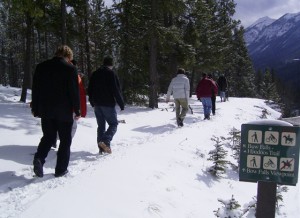Currently a Research Fellow at The Banff Centre in Canada, 25 year old Australian media artist and digital game designer Anita Johnston boasts an impressive folio of art-based games, projects that persistently explore the dialogue between overlaid and enhanced realities. Five years of commercial and arts-funded experience have seen her receive multiple international residencies and commissions, and her game development collective, Yumi-Co, have exhibited their games in galleries and festivals across Australia, England, Prague, the United States and Canada.

Sally Sanrio faces the CuteXdoom temple
Johnston began her game development experience in 2001 after receiving a scholarship to study game design at Brisbane’s Qantm. There she and fellow Yumi-Co member Luke Illett created a prototype for a non-violent, online, musical game. Spookyville was a Wild Tangent mod that allowed players to sample and compose sounds in a gritty, urban, 3D environment. Scrounging around the graffiti-smeared maps, players collected sound samples and engineered their own music tracks to complete game objectives. Spookyville allowed Johnston to fuse her background in photography, graffiti, illustration and music videos with her passion for digital games, and pushed the theme of aesthetic exploration as a device to unravel game play; a paradigm more fully explored in her subsequent game designs.
Upon graduation Johnston was hired by Krome Studios as a designer on Playstation2, XBox and Nintendo titles, but after two years commercial experience, she began what has become an ongoing relationship with The Banff Centre in Canada. During a 2003 residency program there, she produced a candy-themed game prototype that eventually grew into Yumi-Co‘s gorgeous online game UndeRlanD. Commissioned by digital art magazine Horizonzero, and developed in Axel, a commercial web-based 3D engine, UndeRlanD is part fairytale, part nightmare. A contemporary but macabre interpretation of traditional stories of Alice in Wonderland and Hansel and Gretel, players embody Alice as active participants in an illusionary world, and are encouraged to explore the nonsensical environment to locate new lands hidden within the game.
Johnston’s 2003 residency was followed by a year at The Banff New Media Institute’s Mobile Lab, working again with Illett to create a commissioned series of educational games. Their online series explored science and physics, and the games were eventually delivered to isolated, rural students.
Throughout this period Yumi-Co expanded, incorporating Canadian artists and programmers Mike Pelletier and David Gauthier. The enlarged collective produced the Unreal Tournament 2003 mod, CuteXdoom, a single player, single level game which matured the collective’s thematic appreciation of hyper-mediated convergence in popular culture. CuteXdoom explores contemporary culture’s obsession with cuteness and fabricated entities; a cultural facet once particularly Japanese but now wholly global. Familiar gaming mechanics are enacted by the player, however the content is simultaneously satirical and embracingly saccharine. In CuteXdoom your biggest fear is a robotic panda ‘eck!’, who you must appease with toys collected from the forest wilderness. This deified cultural icon rewards the player with a personal horoscope, but the news is not always the best.
For 2005, Johnston is again based at The Banff Centre, collaborating with the Mobile Digital Commons Network, a collective now developing a series of inter-connected, location based games and cinematic experiences for specific sites in Montreal, Banff and Finland. Banff’s contribution to the project, Trickster is a content-rich game for the mobile platform that concentrates on lush cinematics in the game’s cut scenes. The sophisticated graphic treatment is in stark contrast to the familiar pseudo-80’s graphics, and text-based interfaces more frequently seen on the low-end mobile platform. This is ground breaking technology so don’t expect it to be on your phone next week.

UndeRlanD
The real life (RL) physical landscape of the Banff National Park forms a springboard for the Trickster’s narratives. Players must assume the role of a native animal, either a raven, wolf or bear. Trekking through the 5kms of wilderness mapped out in the game, players engage in a series of minigames and character-driven objectives. The majority of game play relates to specific areas of the game, for example, characters can only eat where the RL animals’ food sources are available. Each character is harassed by a coyote who intermittently decreases health points. Several narratives are overlaid in Trickster, interweaving local ecology with parks management challenges and environmental issues.
The technology used to drive Trickster is being developed by the Mobile Lab/ Wearables Lab at the Banff Centre. Sensor-based technologies such as accelerometers (which measure acceleration and the effects of gravity), and G.P.S. form the game interface, a highly sensitive, gestural interface which can measure movement, breathing and heart rate, among others things. To put this technology into a usable format, custom boards with an accelerometer and bluetoooth chip were produced by engineers, and couture armbands were produced by a fashion designer.

Playing Trickster
This armband measures player location and movement, and determines your status based on what the player is up to. These states are reflected in the actions of the on screen character. For example, the screen character moves when you do, and remains stationary as you pause, and when used in the presence of other players, a ‘throw’ gesture causes audiovisual responses in their handset. The position locators inform you of the range of other players, and whether or not you can engage in play with them.
This gesture based play moves away from combat style VR games where you could watch player’s pound or thrash around in a gaming enclosure punching and grunting against the invisible opponent. In Trickster the clunky gear is gone and you might say you wouldn’t look out of place in a RL environment articulating the actions that drive the game.
When considering games played in RL, particularly in a natural environment such as Banff, one finds it quite natural to be carried away by utopian dreams of inhabiting a game space with the power of hyperreal projection, such as portrayed in Cronenberg’s eXistenZ. In eXistenz the game was a VR projection, where player’s bodies stayed grounded, and they were mentally projected into the cinematic game experience. In Cronenberg’s projection, gamers were subjected to a distopian reality as RL and the game world imploded on each other – leaving the players disorientated, paranoid, and trapped.
In Trickster one sees a realised example of the gamer physically placed in the great outdoors, and within a game experience of at least cinematic detail, completing a mental and physical loop. The relationship between RL and the game space is distinguishable from that of VR games in that the trail beneath your feet is no longer paved with well-trod polygons but granite and turf. Through Trickster there is the potential for the game, a RL environment, and player’s realities to become interlocked, each enhancing the other.
The result of pushing wireless gaming content into a natural environment driven through sensor and gesture based technology is intriguing. The Trickster prototype will be completed in June 2005.
Andrea Blundell
Andrea Blundell is a visual effects coordinator currently based in Adelaide, and previously a member of Selectparks.
 This work is licensed under a Creative Commons Attribution-NonCommercial-ShareAlike 2.5 Australia.
This work is licensed under a Creative Commons Attribution-NonCommercial-ShareAlike 2.5 Australia.






